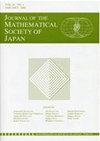关于一般型的高维极值变体
IF 0.7
4区 数学
Q2 MATHEMATICS
引用次数: 3
摘要
基本不变量之间的关系在代数几何中起着重要作用。已知一个具有nef正则除数和正则奇点的一般类型的n维变种,其在正则映射下的像Y为最大维,满足KX≥2(pg−n)。我们研究了非常有趣的极端情况KX=2(pg−n),它出现在许多几何情况下。由于这些极端变种是Horikawa表面的天然高维类似物,我们将其命名为Horikawa变种。藤田[Fuj83]和小林[Kob92]的作品中已经对这些品种进行了处理。我们对Horikawa变种进行了进一步的研究,证明了关于它们的各种几何和拓扑问题的新结果。特别地,我们证明了在正则映射下图像为奇异的Horikawa变种的几何亏格是有界的。我们给出了极化超椭圆亚正则变种的类似结果,特别是极化Calabi-Yau和Fano变种。出现的令人愉快的命理学将Horikawa的结果从更广泛的角度展现出来。我们得到了Horikawa变种的一个结构定理,并探讨了它们的多正则性。我们用它来证明多正则线性系统的投影正规性的最优结果。我们研究了Horikawa变种的基本群,表明它们是简单连接的,即使Y是奇异的。我们还证明了Horikawa变种变形的结果,其对模量空间的影响使它们成为亏格2曲线的高维模拟。本文章由计算机程序翻译,如有差异,请以英文原文为准。
On higher dimensional extremal varieties of general type
Relations among fundamental invariants play an important role in algebraic geometry. It is known that an n-dimensional variety of general type with nef canonical divisor and canonical singularities, whose image Y under the canonical map is of maximal dimension, satisfies K X ≥ 2(pg − n). We investigate the very interesting extremal situation K X = 2(pg−n), which appears in a number of geometric situations. Since these extremal varieties are natural higher dimensional analogues of Horikawa surfaces, we name them Horikawa varieties. These varieties have been previously dealt with in the works of Fujita [Fuj83] and Kobayashi [Kob92]. We carry out further studies of Horikawa varieties, proving new results on various geometric and topological issues concerning them. In particular, we prove that the geometric genus of those Horikawa varieties whose image under the canonical map is singular is bounded. We give an analogous result for polarized hyperelliptic subcanonical varieties, in particular, for polarized Calabi-Yau and Fano varieties. The pleasing numerology that emerges puts Horikawa’s result on surfaces in a broader perspective. We obtain a structure theorem for Horikawa varieties and explore their pluriregularity. We use this to prove optimal results on projective normality of pluricanonical linear systems. We study the fundamental groups of Horikawa varieties, showing that they are simply connected, even if Y is singular. We also prove results on deformations of Horikawa varieties, whose implications on the moduli space make them the higher dimensional analogue of curves of genus 2.
求助全文
通过发布文献求助,成功后即可免费获取论文全文。
去求助
来源期刊
CiteScore
1.40
自引率
0.00%
发文量
56
审稿时长
>12 weeks
期刊介绍:
The Journal of the Mathematical Society of Japan (JMSJ) was founded in 1948 and is published quarterly by the Mathematical Society of Japan (MSJ). It covers a wide range of pure mathematics. To maintain high standards, research articles in the journal are selected by the editorial board with the aid of distinguished international referees. Electronic access to the articles is offered through Project Euclid and J-STAGE. We provide free access to back issues three years after publication (available also at Online Index).

 求助内容:
求助内容: 应助结果提醒方式:
应助结果提醒方式:


